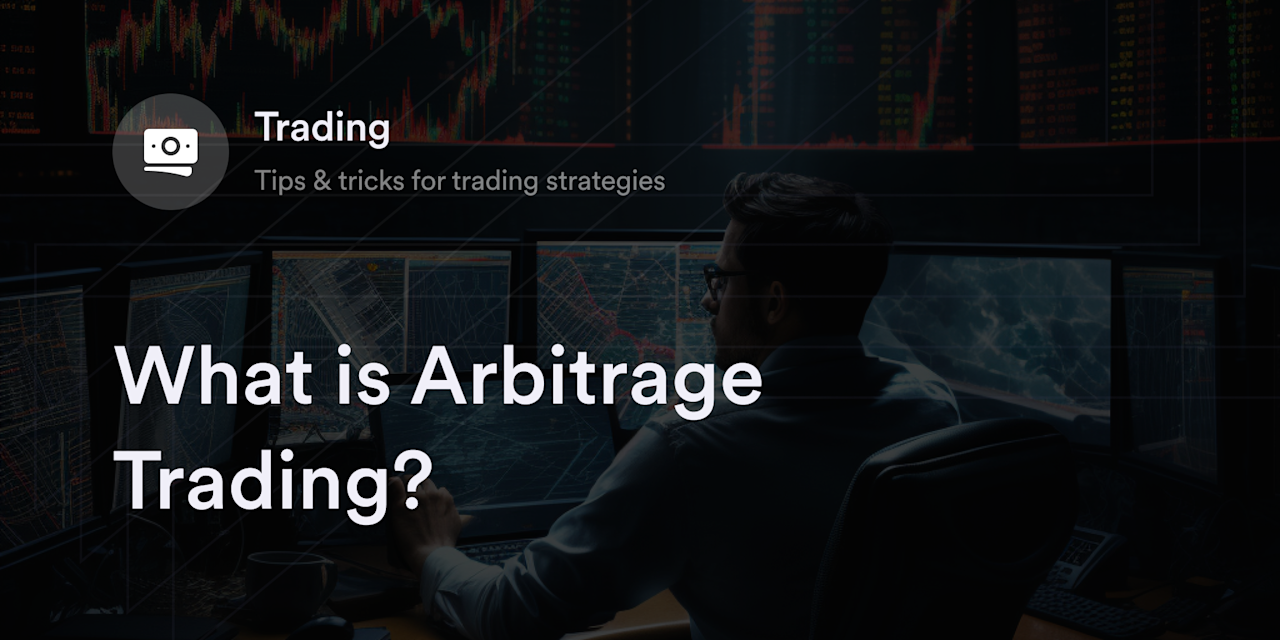


No matter how much data newbies read about digital assets, taking the first leap into the crypto market is often a nerve-wracking experience because of the risk involved. Although cryptocurrencies have never been more accessible on mainstream trading platforms, the dramatic price swings associated with coins like Bitcoin (BTC) are enough to make even a seasoned trader's stomach churn.
In fact, around 40% of new traders claim the cryptocurrency market's volatility is so stressful that they give up within the first month. However, for those with a clear vision and firm discipline, the sharp spikes and dips in cryptocurrencies provide many prime short-term pouncing opportunities.
For beginners, trading cryptocurrencies may seem like an impossible feat, but there are strategies you can use to successfully navigate this choppy market. Here’s some information you need to know about how to trade cryptocurrency, including its pros and cons.
What is Crypto Trading?
Crypto trading means buying and selling virtual currencies on the crypto market in short timeframes. Some crypto traders rarely wait more than a month to open or close their positions. The goal is to generate consistent profits by speculating on the crypto market’s near-term price movement.
How Does Cryptocurrency Trading Work?
People use many trading styles and strategies to find opportunities, place trades, and manage their crypto positions. No matter which method they pick, they need to choose the cryptocurrency they want to trade and open an account on a crypto trading platform.
Also, the range of cryptocurrency exchanges and available digital assets is growing each year, but there are four broad categories most crypto trading options fall into.
Centralized Versus Decentralized Crypto Trading
In the context of crypto trading, "centralized" and "decentralized" refer to the organization and operation of a crypto trading platform.
Centralized crypto exchanges (CEXs) are companies that use "orderbooks" to match buyers and sellers in the crypto market. For context, orderbooks are centralized lists of crypto transfers between traders on the CEX's platform—examples of CEXs include Coinbase and Gemini. While the centralized organization of orderbook requests makes it easy to match buyers and sellers, traders need to place significant trust in a CEX's security practices.
When people sign up for a CEX account, they typically have to share personal know-your-customer (KYC) data like their name and home address to comply with anti-money laundering (AML) laws. Therefore, traders must feel comfortable with CEXs holding this personal info in their databases. Also, on a CEX account, traders use custodial wallets to store their digital assets rather than self-custodial wallets.
As the name implies, custodial wallets are maintained by someone else (in this case, a CEX), while self-custodial wallets provide owners direct access to their crypto. In other words, only the CEX knows the essential passcode to everyone's crypto account. Only after a CEX user transfers crypto from their CEX account to a self-custodial wallet do they have ownership over their crypto.
A major difference between CEXs and decentralized crypto exchanges (DEXs) is the latter category links directly with self-custodial crypto wallets, so traders never lose custody over their crypto. Unlike CEXs, DEXs are built on top of decentralized computer protocols (aka blockchains) like Ethereum (ETH) or Solana (SOL).
Most often, DEXs use self-executing programs called smart contracts to handle trades on their platforms rather than keeping a centralized orderbook. Some DEXs like Uniswap let users contribute to smart contract protocols called liquidity pools and use algorithms to adjust the balance of these pools as people trade crypto in them. By contrast, some like dYdX use a hybrid on- and off-chain orderbook method to provide eligible traders with fast trade finality without sacrificing decentralization.
Many cryptocurrency traders prefer using DEXs because they enjoy full custody over their cryptocurrency and don't have to supply KYC data. However, since DEXs are a new technology, they often aren't as intuitive for beginners and don't offer some of the conveniences found on CEXs (e.g., customer support and potential insurance protections).
Spot Versus Derivatives Crypto Trading
Trading crypto on the spot market is pretty straightforward. It requires someone to buy coins or tokens directly from an exchange and put them in a crypto wallet. For instance, if you buy 0.5 BTC on a spot crypto exchange, you hold 0.5 BTC in your account.
Crypto derivatives, however, work a bit differently. These are assets that give traders price exposure to a cryptocurrency without literally owning the underlying asset. For example, a Bitcoin perpetual swap is a contract speculating on the future direction of Bitcoin's price. When you buy a Bitcoin perpetual contract on a DEX, you don't literally hold BTC in your wallet but have exposure to BTC's price action.
Crypto derivative products are popular in the trading community because they tend to be more flexible than buying spot crypto. When buying and holding spot cryptocurrencies, you always bet the digital asset will rise in price. With derivatives, however, it's easier to bet a digital currency will fall (i.e., to "short" a cryptocurrency). Derivatives also allow you to increase your position size with leverage. On the downside, these don't give you direct access to virtual currencies, so they aren't suitable if you want custody over a digital asset.
How to Start Trading Cryptocurrency
Participating in crypto trading sometimes appears complex, but with only a few basic steps, you can get started. No matter which cryptocurrency or platform you want to use, there are four considerations to keep in mind when starting:
Define a crypto trading strategy: Before signing up for a CEX or linking to a DEX, you need a clear "game plan" for approaching the crypto market. Review different asset categories, techniques, and risk profiles to determine which exchange offers the best features and how to tackle trading crypto.
Sign onto a crypto exchange: After defining a crypto trading strategy, choose an exchange offering the features and digital assets you want to trade. As mentioned, when using a CEX, you’ll have to submit KYC data to open an account, but if you opt for a DEX, you need to download a compatible self-custodial crypto wallet.
Fund your crypto trading account: Each exchange has different methods for people to send fiat or crypto funds for trading. For instance, most CEXs link to a bank account for ACH or wire transfers, while some DEXs offer services to transfer a fiat currency like the U.S. dollar (USD) into stablecoin USDC.
Put trading strategy into practice: After funding an exchange account, it's time to implement a crypto trading thesis. Monitor and evaluate the success of each crypto trade to determine whether a strategy needs a few tweaks.
Examples of Crypto Trading Strategies
Each crypto trader has a personal method for taking positions and monitoring their portfolio. Although every trader's strategy is unique to their preferences and risk tolerance, there are a few general strategies to consider when developing a trading style:
Day trading: A day trader opens and closes crypto positions in 24-hour intervals to capitalize on microtrends in the crypto market. Since day traders sell all their crypto after one session, they don't have to worry about market volatility affecting their portfolios when not actively trading.
Swing trading: Swing trading is like day trading, except traders hold their positions for a few days or weeks. The benefit of swing trading is it gives traders more time for a price hypothesis to play out.
Technical trading: The field of technical analysis analyzes cryptocurrency price charts for patterns, probabilities, and key levels to set up a trade. Traders often draw lines on charts or use tools like moving averages and Fibonacci retracements to visualize the direction of a cryptocurrency's price and decide when to buy and sell their position.
Range trading: Related to technical trading, range traders look to take positions in cryptocurrencies with relatively low volatility in a predictable price range. For instance, if Bitcoin has been trading between $25,000 and $30,000 over the past few months, a range trader might buy BTC at $25,000 and set a sell order close to $30,000.
Arbitrage trading: Arbitrage traders focus on exploiting price inefficiencies between crypto exchanges to profit from these differences. For instance, if ETH trades for $1,500 on Coinbase and $1,515 on Uniswap, an arbitrageur may buy one ETH on Coinbase and sell it on Uniswap for a $15 profit.
Find More Crypto Trading Guides on dYdX
On dYdX's decentralized exchange, eligible traders can enjoy dozens of features to set up their perfect derivatives strategies. Once an eligible trader links their crypto wallet to dYdX's platform, they will have access to a wealth of crypto perpetual swaps, slippage tolerance controls, and up to 20x leverage. For more details on dYdX's trading features, check out the latest posts in our official blog. Plus, if you’re interested in learning more about the crypto ecosystem, check out our beginner-friendly crypto guides on blockchain technology on the dYdX Academy.
Eligible traders can start trading on dYdX today!







